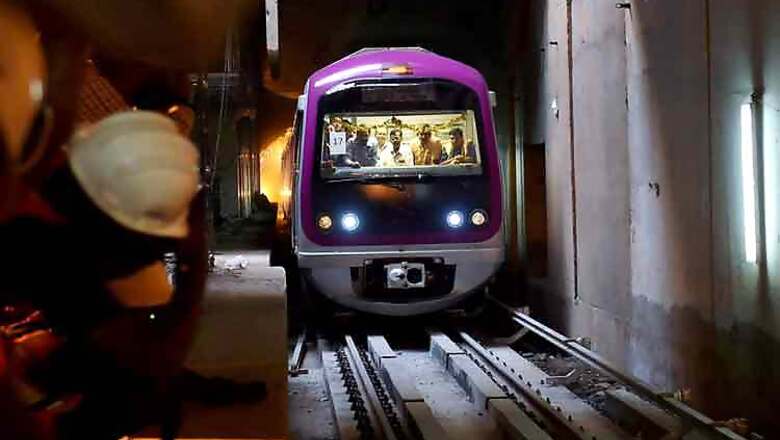
views
Bengaluru: In the year 2011, Bengaluru got its first metro train, also called as 'Namma Metro'. From its inception, 'Namma Metro' has followed a weird language policy. It welcomes its passengers with sign boards and announcements in Kannada, English and Hindi. On close examination it becomes clear that the language policy of ‘Namma Metro’ is actually not driven with intentions to make navigation easy for the masses. Let us see how.
Flawed understanding of cosmopolitanism
To justify the use of Hindi in Namma Metro, there are arguments that Bengaluru is a cosmopolitan city and hence, the use of Kannada and English is not sufficient. What such an argument fails to consider is that the cities like Dubai, Hong Kong and Kuala Lumpur which are much more cosmopolitan than Bengaluru, have only two languages used in their Metros. Language of the land and English, being the two languages used in metros there. The recently inaugurated Chennai metro has adopted two language policy, Tamil and English. Even the Delhi Metro operates only in two languages, Hindi and English. Does this fact make the city of Delhi any less cosmopolitan?
Language policy adopted in Namma Metro
When an RTI query was filed with Bangalore Metro Rail Corporation Limited, seeking details on the language policy adopted in Namma Metro, the reply received was shocking. As per the response to the RTI query, BMRCL has framed its own language policy and has decided to include Hindi. There is no directive either from GOK or GOI to compulsorily use Hindi in Bengaluru Metro. With that understanding, let us ponder over two other questions.
1. Is including Hindi language in 'Namma Metro' a people-friendly move, as a few claim it to be?
2. Even if this language policy was formed internally by BMRCL, why was Hindi included?
More deserving languages than Hindi
Going by the population census, after Kannadigas, the next most populous linguistic communities in Bengaluru are Telugu, Urdu and Tamil speakers in that order. None of their languages has been used in ‘Namma Metro’.
Indian Readership Survey data of 2011 reveals that Kannada dailies, with a readership of 16.2 lakhs and English dailies, with a readership of 9.5 lakhs, dominate the list of top ten 'most read' newspapers in Bengaluru. Kannada dailies Vijaya Karnataka and Prajavani were the most read newspapers in the year 2011, followed by the English daily The Times of India. In the list of top 10 newspapers of Bengaluru, apart from Kannada and English dailies, only the Tamil newspaper 'daily thanthi' has found the eighth slot with 88,000 readers. There is not a single Hindi daily in the Bengaluru's top 10 newspapers' list.
This data is enough to say that Kannada and English reach the masses in Bengaluru. It is unfair and illogical to give prominence to a language like Hindi, which ranks probably sixth or seventh in terms of the number of speakers in Bengaluru. Especially when the third, fourth and the fifth largest linguistic communities are ignored, just to accommodate Hindi. This leads us to the question, why does Hindi get importance always ahead of other much deserving Indian languages?
Language Policy of the Union Government breeds inequality
Answer to this question is in the flawed language policy adopted by the Union Government of India, ever since the current political India was formed. The constitution of India has made it the job of the Union Government to work towards making Hindi more and more acceptable across the geography of the Indian Union. The prolonged special treatment to Hindi by the Union Government of India, is what has caused the perception that everything related to Union Government must have Hindi in it. Such a perception has ensured that Hindi made its way even to ‘Namma Metro’, while the more deserving languages were pushed aside.
The three language policy that was supposed to be adopted in schools, seems to have found its way into every establishment that is associated with the Union Government one way or the other. Even the Kannada Development Authority, in a recent letter to BMRCL, has asked the BMRCL to ensure that the three language policy is followed. While there is no constitutional obligation on BMRCL to follow the three-language policy, the Kannada Development Authority insisting on three-language policy’s usage shows the awareness levels regarding the three-language policy. This lack of awareness displayed by the Kannada Development Authority is a different debate altogether.
End to discrimination
This preference to Hindi is nothing but discrimination against the several other linguistic groups that are part of the Indian Union. The only solution to this glaring discrimination is, to bring in linguistic equality in the Union of India. Linguistic equality can be achieved by declaring all the 22 languages in the eighth schedule of the constitution of India as the official languages of the Union Government. Only then, Hindi will stop taking place of other 'more deserving' languages, under the guise of being people-friendly.
(S Vallish Kumar is a writer-designer. Believer of mother tongue based education.)

















Comments
0 comment